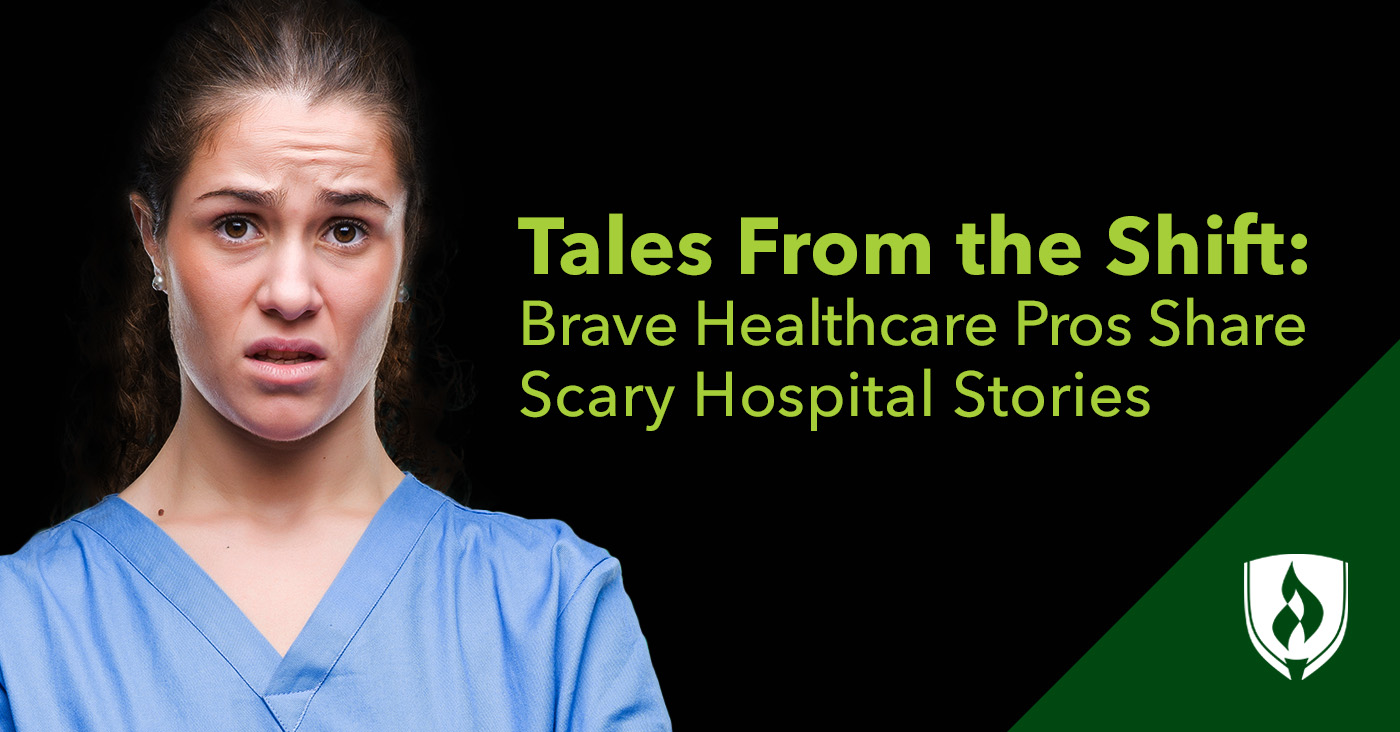Tales From the Shift: Brave Healthcare Pros Share Scary Hospital Stories
By Kristina Ericksen on 10/24/2017

It’s the time of year for things to go bump in the night during your overnight shift and for call lights to mysteriously flicker on. Halloween is a time when we like to get spooked, but for the healthcare community, thrills are a regular occurrence. When you never know who or what your next shift will bring, everything from near-mistakes to unruly patients can turn a regular day into a heart-pounding thriller.
But don’t think for a second it scares off the dedicated professionals in the healthcare industry. They’re brave enough to face whatever comes their way and tough enough to leave with a smile on their faces. It’s just a part of their exciting everyday lives in healthcare.
But don’t take our word for it! We’ve asked nurses to share some of their most hair-raising moments while in scrubs. Keep reading for three scary hospital stories from healthcare professionals themselves.
3 Scary hospital stories that kept healthcare pros on edge
1. A close call in his first nursing job...
Everyone makes mistakes, but mistakes in the medical field can cause serious injury, or worse—a patient’s life. Nick Angelis, CRNA, MSN and author of How to Succeed in Anesthesia School (And RN, PA, or Med School), recalls in his own words a close call he had in his first few months on the job as a nurse:
“‘Don’t show fear on your face,’ I thought to myself as I raced down the hospital hallway as fast as my hideous white nursing shoes could take me. I could hear my nurse preceptor breathing heavily a few steps behind me. Any second and the gastroenterologist would cut a hole into the abdomen of my patient to place a feeding tube. Any second and she could bleed to death from the anticoagulant I accidentally switched for her routine antibiotic.
“We finally reached the procedure area, where a preoperative nurse was staring at the empty IV bag of Argatroban hanging over my patient where Vancomycin should have been.
“‘Stop!’ my preceptor yelled, and then broke down in tears. I felt terrible but could only manage to wrinkle my face into a disheartened frown. Sometimes being the calm one had its disadvantages. The patient was fine, but I couldn’t help thinking, ‘I’m two months into my first job as a registered nurse. How am I going to make it in anesthesia school if I’m such a moron?’”
Every new nurse is at least a little scared of making a dire mistake like this. That’s the reality of a life-and-death industry. Fortunately for Angelis, the close call only resulted in a scary situation at work and a lesson learned the hard way.
2. A close shave with a traumatized patient...
Not all patients are happy campers, which is understandable when painful and stressful conditions bring them into the hospital. Patient-facing healthcare professionals can sometimes bear the brunt of unruly patients or even their frustrated family members. Diffusing these encounters while maintaining their cool is the hallmark of a healthcare professional.
“I had a disgruntled patient pull a knife,” recalls Becky McKeown, RN. “He was very agitated and flipped out before a skin cancer surgery. He was a veteran with a bad case of post-traumatic stress disorder (PTSD).”
Because McKeown had a loved one with PTSD, she knew confrontation with the patient would only make the situation worse, but still needed to act quickly. She says she instinctively grabbed a scalpel as a measure of self-defense, but also worked to verbally deescalate the situation as soon as possible.
Fortunately, cooler heads prevailed as she was able to talk the patient down and eventually get him to drop his knife. Despite the scary turn of events, McKeown walked away from the encounter unscathed. Because she was able to keep her wits about her, she was able to calm the potentially volatile and dangerous situation for the wellbeing of everyone involved.
3. Down to the very last drop...
Accompanying a critical organ donor in flight to a hospital, Wendie Howland, MN RN-BC CRRN CCM CNLCP LNCC and principal of Howland Health Consulting, recalls a situation that came as close as it can possibly get—down to the very last drop:
“When I was younger I worked in the Intensive Care Unit (ICU) and did a lot of critical care transport in small planes around northern California. I was in a small plane transporting an extremely critical organ donor whose blood pressure required maximal pharmacological support. One little decrease in that stuff, and his blood pressure just tanked. I had never given so much of this stuff before and I never watched a drip so closely in all my life—this was before pumps.
“I’d done a lot of donor runs, so I had brought a lot of extra supplies, because once you’re out in the rig or up in the plane, you can’t send out for something you missed. But even with triple supplies, we were approaching land and I was on my last bag of pressor. I realized that since it was running wide open it was going to run dry before I’d get to the hospital. So I had the pilot call the ICU and tell them to have the Emergency Room crew meet us at the door with a new bag.
“The ER nurse ran out to meet the ambulance, and literally the last drop—the very last drop—fell into the drip chamber as I grabbed it and plugged it in. The BP dropped like a shot for a second … and then rebounded. We made it upstairs to the ICU, and all was well.”
Had Howland not stocked her donor run flights with so many extra supplies, this story might have had a tragic ending. Fortunately, her patient overcame the close call thanks to Howland’s caution and foresight in flight.
What are you afraid of?
Healthcare pros face their share of scares like these, but their dedication keeps them doing their part to provide great healthcare to patients. Heart-pounding moments are just a part of the fast-paced nature of the healthcare industry, where every day brings something new.
Did these scary hospital stories send a shiver down your scrubs?
Here’s something even scarier: Hospitals are actually one of the most dangerous places to work. Between the germs, physical strains on workers and exposure to illness, hospitals are even more hazardous than working in construction and manufacturing.
RELATED ARTICLES:




